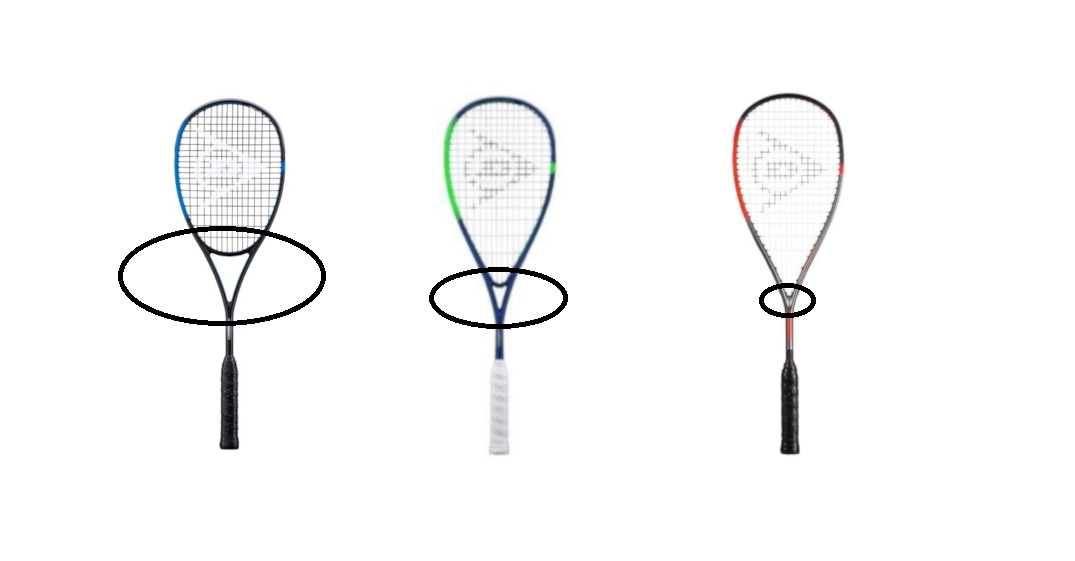Open throat or closed throat, which is which?
There was recently a small debate in the comments section of one of our blog posts regarding this very question. The blog post itself is a guide to what type of racquet will suit your game and whether you would benefit most from an open throat or a closed throat racquet.
Our blog post referred to a teardrop shaped racquets as open throat and racquets with a bridge as closed throat, however, a person with significant experience in the stringing business commented that we had the terms open and closed throat the wrong way around. He made some very good points which prompted us to do some deeper digging and write this blog post.
You can read the comments for yourself using this link - https://blog.controlthet.com/blog/what-squash-racquet-to-buy-should-i-get-an-open-or-closed-throat
Reddit is arguably a less reliable source to use, so we'll start with that. I found a thread discussing this very topic, although the original poster is enquiring into whether or not to purchase open or closed throat racquet, the top response details their view on the difference between the two:
'The difference between open and closed throat racquets is due to the length of the main strings (the ones that run the same direction as the handle). Open throat racquets have longer strings, so they stretch further and snap back with more vigour, hence more power. The closed throat racquets have shorter mains, so the strings flex less, allowing for less variance in bounce from the strings and hence more control.'
This links open and closed throat racquets to string beds and the general assumption in squash teardrop racquets are better for power and racquets with a bridge are better for control, which isn't necessarily always true (but that's a different discussion)!
(Link to the SubReddit here - www.reddit.com/r/squash/comments/42bgxz/rackets_open_throat_vs_closed/ )
Could tennis history be the answer?
Looking into the evolution of the tennis racquet, if you think back to older tennis racquets and compare them to modern style racquets, older racquets had a solid wooden throat whereas modern racquets all have a bridge.
The article linked underneath the photograph refers to open throat racquets as racquets with a bridge at the throat (on the right), and closed throat racquets as the older style racquets (on the left). Older squash racquets had a similar look to them as older tennis racquets, they featured a long neck with no bridge, this could indicate that the terminology is transferable between both sports. Many other tennis related sources state the same.
Major Squash Retailers...
Many esteemed squash retailers such as PDH Sports and Sweatband do refer to teardrop shaped racquets as open throat and classic racquets with a bridge as closed throat (in the two articles linked below). It could be argued that, as brands like these two are highly established in the world of squash, they have a certain level of credibility.
PDH Sports article on How to Choose a Squash Racquet - https://www.pdhsports.com/buying-guides/squash-buying-guides/how-to-choose-a-squash-racket-what-you-need-to-consider
Sweatband article on Choosing The Right Squash Racquet - https://active.sweatband.com/squash/choosing-right-squash-racket.html
HOWEVER... (and that's a big however)
There are also established squash brands, such as Harrow, who refer to their own racquets with a bridge as open throat racquets (seen in their description of the Vapor Ultralite here - https://www.harrowsports.com/collections/squash-racquets/products/harrow-vapor-ultralite-squash-racquet).
It's interesting that there is so much discrepancy in what squash players view as an open vs closed throat racquet to be ...
When we go back further in history it's more clear which is which. The small headed tennis or squash racquet had a pronounced throat under the head. The first racquets that were called open throat had the same basic design but a section of the throat was removed which understandably was called an open throat racquet.
With today's current squash racquet we have 2 predominant shapes. A round/oval shaped head with a bridge and the teardrop head with its much longer main strings.
I think the confusion comes from that it looks like the racquet face is opened up when the bridge is removed from the racquet head and the strings come down further into what would have been the throat of the racquet. If you still consider that area the throat then a teardrop racquet would seem to have the more open throat.
Ultimately though the strings are still part of the head, or racquet face of the racquet and the throat, although much smaller is still solid on a teardrop racquet.
Here's a picture of 3 racquets which what is actually the throat circled.
 The first racquet, the Dunlop Sonic Core Pro 130 has a large throat. The second racquet is the Dunlop Sonic Core Evolution 120 and its throat is much smaller. Both by the historical definition are open throat racquets. The last racquet, the Dunlop Hyperfibre XT Revelation Pro has a very small throat that is considered a closed throat.
The first racquet, the Dunlop Sonic Core Pro 130 has a large throat. The second racquet is the Dunlop Sonic Core Evolution 120 and its throat is much smaller. Both by the historical definition are open throat racquets. The last racquet, the Dunlop Hyperfibre XT Revelation Pro has a very small throat that is considered a closed throat.
To wrap it up, we can see both side of the argument. Furthermore, there are lots of reputable sources for both sides of the argument as well.
To clear up any confusion, we tend to just refer to racquets as traditional or teardrop, rather than referring to them as open and closed throat. It's certainly been an interesting topic to research!
If you have any input, feel free to let us know in the comments...
